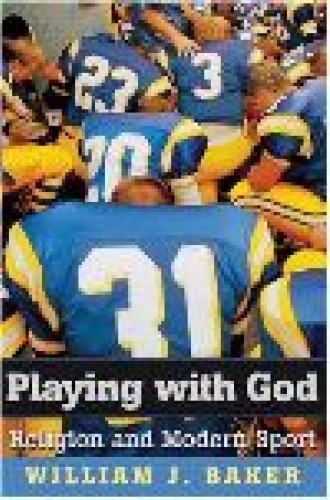Playing with God
Baker, a sports historian and professor emeritus at the University of Maine, has written a valuable story about the engagement of religion with sports. He focuses on U.S. history from the time of the Puritans to the present day, pausing at times to delve deeply into the stories of a few prominent figures, such as Knute Rockne, the tough-as-nails football coach of the Notre Dame Fighting Irish and a convert to Catholicism. As a historian and researcher, Baker is exceptional, and his writing is fluid and energetic.
The Puritans’ attitudes toward athletics were mostly negative. Many viewed sports as crude, distracting and detrimental to moral life. A paradigm shift in the way American religion related to sports came in the 19th century in the form of the “muscular Christianity” movement, imported from Victorian England. The phrase muscular Christianity was first connected to Charles Kingsley, a 19th-century Anglican writer and member of the clergy. The movement arose during the Industrial Revolution, when people were flocking to urban centers for jobs and struggling against the squalor, pollution and unhealthy environs of city life. “In both Britain and the United States,” writes Baker, “the muscular Christian movement began not as a passion for competitive games but rather as a concern for healthy diet, fresh air, and firm muscles.” Here in the U.S. it also seemed to be an outgrowth of self-help efforts. As city life beat them down, morally responsible muscular Christians fought back by keeping their body, mind and spirit in shape. Gradually athletics began to take on a virtuous glow.
The founding of the Young Men’s Christian Association in England in 1844 was one result of the muscular Christian movement. The YMCA sought to form young men into good Christian citizens by offering not only a wide variety of athletic opportunities but also Bible study sessions, worship services and prayer groups. Basketball, the first truly American sport, originated at a YMCA in Springfield, Massachusetts, in 1891. The YMCA was also a major catalyst in what Baker describes as “the alignment of patriotism with sport”; it placed an athletic trainer at every U.S. military base at the beginning of World War I.
From the mid-19th century on, audiences were attracted by religious figures who endorsed athletics and made a facile connection between sports and religion. Americans were ready to play. Recently arrived immigrants used sports as a way to integrate themselves into the American way of life. Baker adroitly discusses how this occurred among Jewish immigrants, who wanted to be viewed as strong and American and were dominant in most major U.S. sports from 1920 to 1940. The sharp decline in the number of Jewish athletic stars mirrored a similar pattern among other immigrant groups: as blue-collar urban life gives way to professional suburban life, there is less of a reason for a group to prove that its members deserve to be called American.
Moderate Protestants and Catholics opened their arms to sports throughout the 19th and early 20th centuries; evangelical Protestants were not as enthusiastic until much later. Baker places the evangelical change of heart sometime between the end of World War II and the end of the Vietnam War. Once evangelicals began to view sports as a way to spread the Good News, they accepted athletics wholeheartedly. A number of athletes began associating with prominent evangelicals such as Billy Graham, who often integrated sports language into his sermons—which were often delivered at sports stadiums. Baker delivers an insightful critique of this marriage between evangelical religion and sports: “Both hold a simple, clear-cut vision of reality that divides the world into winners and losers.”
The book’s final chapter, “Gods and Games Today,” is an abrupt ending to an otherwise well-constructed work. Here Baker offers an overly simplistic pontification on anabolic steroid use that distracts from his scholarship. Undoubtedly steroid use is a troublesome development in athletics, but Baker seems to place the onus solely on the athletes themselves rather than developing a more sophisticated critique of a professional sports system that encourages such behavior—or at least sends out mixed signals.
Baker offers no substantive theological analysis of the facts he presents, but he is not a theologian, and this would admittedly be beyond the scope of his project. Nevertheless, it certainly would have been fascinating to put Baker’s thesis in dialogue with theology.





